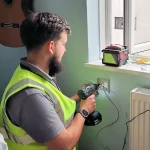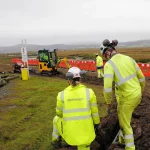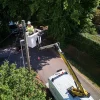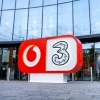Arthur D.Little Report Warns FTTC Broadband is Not Future Proof
A new report from Arthur D.Little and Exane BNP Paribas, which examines the Capital Expenditure (Capex) of European telecoms operators, has warned that incumbent providers will face a growing divide versus cable and pure fibre optic (FTTH/P) ISPs because the cheaper and slower hybrid-cheap (FTTC) approach is “not future-proof“.
The report, which somewhat states the obvious and is based off 118 company meetings across 24 countries in the telecoms and media technology sector, notes that future cable (DOCSIS3.1) networks and existing FTTH/P ISPs (described in the report as “the only competitive technology so far“) have developed a route to reach broadband speeds of 1Gbps+ (Gigabits per second), while FTTC (VDSL) services from incumbents tend to focus more on 100Mbps and below (Megabits per second).
Advertisement
Arthur D. Little estimates that incumbent hybrid-fibre providers will now need to “step-up” their capex by 20% in order to put more fibre optic cable into the ground (e.g. FTTdp, FTTRN, FTTS, FTTB etc.) and boost speeds. “The incumbents will need to spend an additional EUR20bn-25bn on top of what has already been committed, representing an uplift of c.20% to their fixed-line capex over the next 10 years,” said the report.
Meanwhile smaller alternative network providers (altnets) will find themselves “caught between a rock and a hard place“, which is perhaps nothing new given the current regulatory environment and pro-incumbent focus for public investment. “In Germany, the UK, Belgium and the Netherlands i.e. the FTTC/VDSL countries, altnets are likely to have to rely on a wholesale model, with lower EBITDA margins, less opportunity to compete on price and a weaker ability to differentiate compared to the current business model, which is based on the unbundling of the local loop [LLU],” said the report (some already do much of this).
The Key Conclusions
– Telco capex is rising to new peaks, both in mobile and fixed, driven by technological advancements and intense competition, notably driven by cable and mobile leaders.
– In mobile, there are genuine differences in network quality, but so far they have generally not resulted in better pricing power or market share gains. We expect operators to redouble their efforts in this respect – in particular Vodafone.
– This puts pressure on the challengers, which must act. Consolidation is an option but there are others too: network sharing is less risky and brings large savings as well.
– In any case, mobile leaders are likely to end-up facing challengers with scaled networks, in markets which may or may not be repaired, depending on antitrust decisions and whether there are fixed/cable players with strong mobile ambitions.
– In fixed-line, in most countries, cable will continue to extend its lead (route to 1Gbps broadband with DOCSIS3.1). FTTC/VDSL is not future-proof (<100Mbps), so incumbents must move to FTTH or FTTS/FTTB/FTTD with G.Fast. This means another 20% step-up in incumbents’ fixed capex.
– Fixed broadband altnets are caught between a rock and a hard place. We expect to see more consolidation, driven in particular by mobile operators, for whom the bolstering of their fixed broadband business is a matter of defending their mobile core.
– In conclusion, we see higher capex ultimately paying off in fixed-line, but it will cost incumbents more than currently expected; in mobile, we believe that higher capex will lead to a regrouping of networks but not necessarily to a decline in competition.
– We still model revenue decline for European telcos (-1.6% 2013-2016e CAGR), with a contraction in mobile and growth in fixed broadband; but after a dreadful 2013 (revenues down 5%, with -9% in mobile), we expect the decline to slow from 2014e.
It’s worth pointing out that the 20% capex figure assumes that incumbents offering FTTC (VDSL) based services, such as BT’s up to 80Mbps capable “fibre broadband” platform, will move on to more fibre rich solutions (like the examples given earlier) and combine them with G.fast (aka – FTTC2) technology to reach speeds of 0.5-1Gbps by reducing the length of remaining copper wire. “The cost is lower and the rollout is easier and quicker than FTTH,” said the report.
This 13th edition of the joint annual report by Exane BNP Paribas and Arthur D. Little can be read HERE, although it’s somewhat subjective given that the majority of operators interviewed appeared to be big providers. However the advocated longer-term approach seems to mirror planned developments in the United Kingdom, with Virgin Media expected to adopt DOCSIS3.1 and BT looking at FTTdp/RN + G.Fast.
Advertisement
Admittedly we’d rather there was a national strategy for FTTH/P but finding the tens of billions needed to do that has always been a huge stumbling block (scrap HS2?). In addition, we doubt many would be pleased if all of the funding for something as big as FTTH then ended up going into BT’s pocket again. Sky Broadband and TalkTalk are however already experimenting with their own alternative approach in York (here).
Mark is a professional technology writer, IT consultant and computer engineer from Dorset (England), he also founded ISPreview in 1999 and enjoys analysing the latest telecoms and broadband developments. Find me on X (Twitter), Mastodon, Facebook, BlueSky, Threads.net and Linkedin.
« ITU Ranks UK 7th Globally for Fixed Broadband Subscriptions by Speed


















































Comments are closed